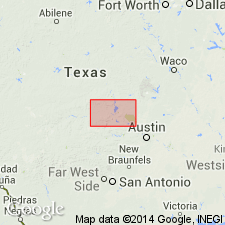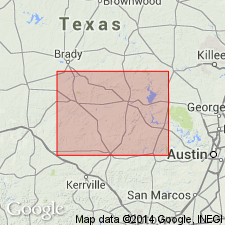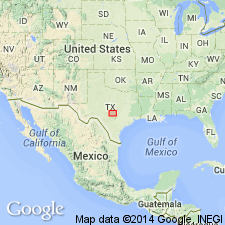
- Usage in publication:
-
- Wilberns formation*
- Modifications:
-
- Original reference
- Dominant lithology:
-
- Limestone
- Shale
- AAPG geologic province:
-
- Llano uplift
Summary:
Pg. 28. Wilberns formation. Limestone and shales, the shales occupying approximately upper third of formation, 170 to 220 feet thick. Overlies Cap Mountain formation and underlies Ellenburger limestone without any detected unconformity. [Age is Late Cambrian.]
[Named from Wilberns Glen, Llano Co., central TX.]
Source: US geologic names lexicon (USGS Bull. 896, p. 2332).

- Usage in publication:
-
- Wilberns formation*
- Modifications:
-
- Mapped
- Dominant lithology:
-
- Limestone
- Shale
- AAPG geologic province:
-
- Llano uplift
Summary:
Wilberns formation. [Follows definition of Paige (1911). For faunal subdivisions of Wilberns formation and Ellenburger limestone and for inconstant boundary between the two formations as mapped, see C.L. Dake and Josiah Bridge, 1932, GSA Bull., v. 43, p. 725-748.]
Source: US geologic names lexicon (USGS Bull. 896, p. 2332).

- Usage in publication:
-
- Wilberns formation*
- Modifications:
-
- Contact revised
- AAPG geologic province:
-
- Llano uplift
Summary:
Lower contact revised in that Welge sandstone member, basal member of Wilberns formation overlies the Lion sandstone member, upper member of the newly named Riley formation Welge sandstone, Morgan Creek limestone, San Saba limestone, and Pedernales dolomite members described. Geologic maps of these members in San Saba, Blanco, Gillespie Cos., TX, Llano uplift. Cross section. Of Late Cambrian age.
Source: GNU records (USGS DDS-6; Denver GNULEX).

- Usage in publication:
-
- Wilberns formation*
- Modifications:
-
- Revised
- AAPG geologic province:
-
- Llano uplift
Summary:
Lower boundary placed at top of Lion Mountain sandstone member of Riley formation. Upper boundary placed at base of Threadgill member of Tanyard formation. Revised in the Llano uplift area of central TX in that it is divided into the newly named (ascending order): Welge sandstone, Morgan Creek limestone, Point Peak shale, San Saba limestone (and its eastward equivalent the Pedernales dolomite member) members. Has an average thickness of about 550 ft ranges between 540 and 610 ft thick; is only 360 ft thick in southeast corner of uplift due to truncation and disconformity. Of Early Cambrian age. Cross sections.
Source: GNU records (USGS DDS-6; Denver GNULEX).
For more information, please contact Nancy Stamm, Geologic Names Committee Secretary.
Asterisk (*) indicates published by U.S. Geological Survey authors.
"No current usage" (†) implies that a name has been abandoned or has fallen into disuse. Former usage and, if known, replacement name given in parentheses ( ).
Slash (/) indicates name conflicts with nomenclatural guidelines (CSN, 1933; ACSN, 1961, 1970; NACSN, 1983, 2005, 2021). May be explained within brackets ([ ]).

